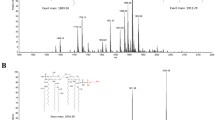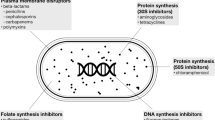Abstract
Purpose
Aztreonam/avibactam is effective against serious infections caused by Gram-negative bacteria including Enterobacterales harboring metallo-β-lactamases. While the utility of this combination has been established in vitro and in clinical trials, the purpose of this study is to enhance our understanding of the underlying mechanism responsible for their activities through metabolomic profiling of a multidrug-resistant Escherichia coli clinical isolate.
Methods
Metabolomic analyses of time-dependent changes in endogenous bacterial metabolites in a clinical isolate of a multidrug-resistant E. coli treated with aztreonam and avibactam were performed. E. coli metabolomes were compared at 15 min, 1 h and 24 h following treatments with either avibactam (4 mg/L), aztreonam (4 mg/L), or aztreonam (4 mg/L) + avibactam (4 mg/L).
Results
Drug treatment affected 326 metabolites with magnitude changes of at least 2-fold, most of which are involved primarily in peptidoglycan biosynthesis, nucleotide metabolism, and lipid metabolism. The feedstocks for peptidoglycan synthesis were depleted by aztreonam/avibactam combination; a significant downstream increase in nucleotide metabolites and a release of lipids were observed at the three timepoints.
Conclusion
The findings indicate that the aztreonam/avibactam combination accelerates structural damage to the bacterial membrane structure and their actions were immediate and sustained compared to aztreonam or avibactam alone. By inhibiting the production of crucial cell wall precursors, the combination may have inflicted damages on bacterial DNA.








Similar content being viewed by others
Data availability
The data presented in the study are deposited in the NCBI BioProject repository, accession number PRJNA1062769.
References
Hutchings MI, Truman AW, Wilkinson B (2019) Antibiotics: past, present and future. Curr Opin Microbiol 51:72–80
Oo C, Zhang X, Sy SKB (2023) Evaluating the status of antibiotic approvals and readiness to combat antimicrobial resistance: what else can we do better? Drug Discov Today 28(8):103674
Oo C, Sy SKB (2020) Learning and augmenting natural processes: potential means of combating antimicrobial resistance from a drug R&D perspective. Drug Discov Today 25(1):1–3
Cornely OA, Cisneros JM, Torre-Cisneros J, Rodríguez-Hernández MJ, Tallón-Aguilar L, Calbo E, Horcajada JP, Queckenberg C, Zettelmeyer U, Arenz D, Rosso-Fernández CM, Jiménez-Jorge S, Turner G, Raber S, O’Brien S, Luckey A (2020) Pharmacokinetics and safety of aztreonam/avibactam for the treatment of complicated intra-abdominal infections in hospitalized adults: results from the REJUVENATE study. J Antimicrob Chemother 75(3):618–627
Sy SK, Beaudoin ME, Zhuang L, Loblein KI, Lux C, Kissel M, Tremmel R, Frank C, Strasser S, Heuberger JA, Mulder MB, Schuck VJ, Derendorf H (2016) In vitro pharmacokinetics/pharmacodynamics of the combination of avibactam and aztreonam against MDR organisms. J Antimicrob Chemother 71(7):1866–1880
Sy S, Zhuang L, Xia H, Beaudoin ME, Schuck VJ, Derendorf H (2017) Prediction of in vivo and in vitro infection model results using a semi-mechanistic model of avibactam and aztreonam combination against multidrug resistant organisms. CPT: Pharmacometrics Syst Pharmacol 6(3):197–207
Davido B, Fellous L, Lawrence C, Maxime V, Rottman M, Dinh A (2017) Ceftazidime-avibactam and aztreonam, an interesting strategy to overcome beta-lactam resistance conferred by metallo-beta-lactamases in Enterobacteriaceae and Pseudomonas aeruginosa. Antimicrob Agents Chemother 61(9):e01008–01017
Falcone M, Daikos GL, Tiseo G, Bassoulis D, Giordano C, Galfo V, Leonildi A, Tagliaferri E, Barnini S, Sani S, Farcomeni A, Ghiadoni L, Menichetti F (2021) Efficacy of ceftazidime-avibactam plus aztreonam in patients with bloodstream infections caused by metallo-β-lactamase-producing Enterobacterales. Clin Infect Dis 72(11):1871–1878
Feng K, Jia N, Zhu P, Sy S (2021) Aztreonam/avibactam effect on pharmacodynamic indices for mutant selection of Escherichia coli and Klebsiella pneumoniae harbouring serine- and New Delhi metallo-β-lactamases. J Antimicrob Chemother 76(11):2875–2883
Stachyra T, Pechereau MC, Bruneau JM, Claudon M, Frere JM, Miossec C, Coleman K, Black MT (2010) Mechanistic studies of the inactivation of TEM-1 and P99 by NXL104, a novel non-beta-lactam beta-lactamase inhibitor. Antimicrob Agents Chemother 54(12):5132–5138
Shields RK, Doi Y (2020) Aztreonam combination therapy: an answer to metallo-β-lactamase-producing gram-negative bacteria? Clin Infect Dis 71(4):1099–1101
Zhu S, Yue J, Wang X, Zhang J, Yu M, Zhan Y, Zhu Y, Sy SKB, Lv Z (2023) Metabolomics revealed mechanism for the synergistic effect of sulbactam, polymyxin-B and amikacin combination against Acinetobacter baumannii. Front Microbiol 14:1217270
Zhu S, Zhang J, Song C, Liu Y, Oo C, Heinrichs MT, Lv Z, Zhu Y, Sy SKB, Deng P, Yu M (2022) Metabolomic profiling of polymyxin-B in combination with meropenem and sulbactam against multi-drug resistant Acinetobacter baumannii. Front Microbiol 13:1013934
Jiang M, Li X, Xie CL, Chen P, Luo W, Lin CX, Wang Q, Shu DM, Luo CL, Qu H, Ji J (2023) Fructose-enabled killing of antibiotic-resistant Salmonella enteritidis by gentamicin: insight from reprogramming metabolomics. Int J Antimicrob Agents 62(3):106907
Zhang J, Yang H, Zhang L, Lv Z, Yu M, Sy SKB, Zhan Y (2023) Comparative metabolomics reveal key pathways associated with the synergistic activities of aztreonam and clavulanate combination against multidrug-resistant Escherichia coli. mSystems:e0075823
CLSI (2024) Performance Standards for Antimicrobial Susceptibility Testing. 34th ed. CLSI document M100. Clinical and Laboratory Standards Institute, Wayne, PA
Zhao J, Han ML, Zhu Y, Lin YW, Wang YW, Lu J, Hu Y, Tony Zhou Q, Velkov T, Li J (2021) Comparative metabolomics reveals key pathways associated with the synergistic activity of polymyxin B and rifampicin combination against multidrug-resistant Acinetobacter baumannii. Biochem Pharmacol 184:114400
Morrison L, Zembower TR (2020) Antimicrobial resistance. Gastrointest Endosc Clin N Am 30(4):619–635
McEwen SA, Collignon PJ (2018) Antimicrobial Resistance: a one health perspective. Microbiol Spectr 6(2):2
Murray CJL, Ikuta KS, Sharara F (2022) Global burden of bacterial antimicrobial resistance in 2019: a systematic analysis. Lancet 399(10325):629–655
Durante-Mangoni E, Andini R, Zampino R (2019) Management of carbapenem-resistant Enterobacteriaceae infections. Clin Microbiol Infect 25(8):943–950
Lutgring JD (2019) Carbapenem-resistant Enterobacteriaceae: an emerging bacterial threat. Semin Diagn Pathol 36(3):182–186
Rodríguez-Baño J, Gutiérrez-Gutiérrez B, Machuca I, Pascual A (2018) Treatment of infections caused by extended-spectrum-β-lactamase-, AmpC-, and carbapenemase-producing Enterobacteriaceae. Clin Microbiol Rev 31(2):e00079–e00017
Wu S, Zong Z (2022) Aztreonam-avibactam: an option against carbapenem-resistant enterobacterales with emerging resistance. Precision Clin Med 5(4):pbac029
Yu W, Xiong L, Luo Q, Chen Y, Ji J, Ying C, Liu Z, Xiao Y (2021) In Vitro Activity comparison of ceftazidime-avibactam and aztreonam-avibactam against bloodstream infections with carbapenem-resistant organisms in China. Front Cell Infect Microbiol 11:780365
Crandon JL, Nicolau DP (2013) Human simulated studies of aztreonam and aztreonam-avibactam to evaluate activity against challenging gram-negative organisms, including metallo-β-lactamase producers. Antimicrob Agents Chemother 57(7):3299–3306
Sy SKB, Derendorf H (2018) Experimental design and modelling approach to evaluate efficacy of β-lactam/β-lactamase inhibitor combinations. Clin Microbiol Infect 24(7):707–715
Eltzschig HK, Weissmüller T, Mager A, Eckle T (2006) Nucleotide metabolism and cell-cell interactions. Methods Mol Biol 341:73–87
Warner DF, Evans JC, Mizrahi V (2014) Nucleotide metabolism and DNA replication. Microbiol Spectr 2(5):5
Pankey GA, Sabath LD (2004) Clinical relevance of Bacteriostatic versus Bactericidal mechanisms of Action in the treatment of Gram-positive bacterial infections. Clin Infect Dis 38(6):864–870
Finberg RW, Moellering RC, Tally FP, Craig WA, Pankey GA, Dellinger EP, West MA, Joshi M, Linden PK, Rolston KV, Rotschafer JC, Rybak MJ (2004) The importance of bactericidal drugs: future directions in infectious disease. Clin Infect Dis 39(9):1314–1320
Kohanski MA, Dwyer DJ, Hayete B, Lawrence CA, Collins JJ (2007) A common mechanism of cellular death induced by bactericidal antibiotics. Cell 130(5):797–810
Farr SB, Kogoma T (1991) Oxidative stress responses in Escherichia coli and Salmonella typhimurium. Microbiol Rev 55(4):561–585
Miller C, Thomsen LE, Gaggero C, Mosseri R, Ingmer H, Cohen SN (2004) SOS response induction by ß-Lactams and bacterial defense against antibiotic lethality. Science 305(5690):1629–1631
Delcour AH (2009) Outer membrane permeability and antibiotic resistance. Biochim Biophys Acta 1794(5):808–816
MacNair Craig R, Brown Eric D (2020) Outer membrane disruption overcomes intrinsic, acquired, and spontaneous antibiotic resistance. mBio 11(5):01615–01620
Ayoub Moubareck C (2020) Polymyxins and bacterial membranes: a review of antibacterial activity and mechanisms of resistance. Membr 10(8):8
Livermore DM, Mushtaq S, Warner M, Miossec C, Woodford N (2008) NXL104 combinations versus Enterobacteriaceae with CTX-M extended-spectrum beta-lactamases and carbapenemases. J Antimicrob Chemother 62(5):1053–1056
Stachyra T, Levasseur P, Pechereau MC, Girard AM, Claudon M, Miossec C, Black MT (2009) In vitro activity of the β-lactamase inhibitor NXL104 against KPC-2 carbapenemase and Enterobacteriaceae expressing KPC carbapenemases. J Antimicrob Chemother 64(2):326–329
Kang Y, Xie L, Yang J, Cui J (2023) Optimal treatment of ceftazidime-avibactam and aztreonam-avibactam against bloodstream infections or lower respiratory tract infections caused by extensively drug-resistant or pan drug-resistant (XDR/PDR) Pseudomonas aeruginosa. Front Cell Infect Microbiol 13:1023948
Funding
This work was supported by Qingdao Key Health Discipline Development Fund.
Author information
Authors and Affiliations
Contributions
All authors (i) contributed to the design of the study, acquisition, or analysis of data, (ii) drafted or revised the article for intellectual content, and (iii) approved the final version.
Corresponding authors
Ethics declarations
Conflict of interest
The authors declare that the research was conducted in the absence of any commercial or financial relationships that could be construed as a potential conflict of interest.
Additional information
Publisher’s Note
Springer Nature remains neutral with regard to jurisdictional claims in published maps and institutional affiliations.
Rights and permissions
Springer Nature or its licensor (e.g. a society or other partner) holds exclusive rights to this article under a publishing agreement with the author(s) or other rightsholder(s); author self-archiving of the accepted manuscript version of this article is solely governed by the terms of such publishing agreement and applicable law.
About this article
Cite this article
Zhou, X., Zhang, J., Chen, J. et al. Metabolomics unveil key pathways underlying the synergistic activities of aztreonam and avibactam against multidrug-resistant Escherichia coli. Eur J Clin Microbiol Infect Dis (2024). https://doi.org/10.1007/s10096-024-04837-4
Received:
Accepted:
Published:
DOI: https://doi.org/10.1007/s10096-024-04837-4




